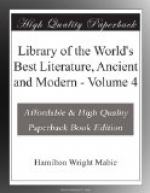An opportunity offering in 1821, he stood for a minor canonry in St. Paul’s Cathedral, London, and obtained it; his income was less than before, but he had entered the metropolitan field, which brought him rich enjoyment and permanent fame. He paid a terrible price for them: his unhealthy London house cost him the lives of three of his children. To make up for his shortened means he became editor of the London Chronicle and a contributor to various other periodicals, including the notorious weekly John Bull, sometime edited by Theodore Hook. In 1824 he became a priest in the Chapel Royal at St. James’s Palace, and soon after gained a couple of excellent livings in Essex, which put him at ease financially.
He was inflexible in principle, a firm Tory, though without rancor. He was very High Church, but had no sympathy with the Oxford movement or Catholicism. He preached careful and sober sermons, without oratorical display and with rigid avoidance of levity. He would not make the church a field either for fireworks or jokes, or even for displays of scholarship or intellectual gymnastics. In his opinion, religious establishments were kept up to advance religion and morals. And both he and his wife wrought zealously in the humble but exacting field of parochial good works.
He was, however, fast becoming one of the chief ornaments of that brilliant group of London wits whose repute still vibrates from the early part of the century. Many of them—actors, authors, artists, musicians, and others met at the Garrick Club, and Barham joined it. The names of Sydney Smith and Theodore Hook are enough to show what it was; but there were others equally delightful,—not the least so, or least useful, a few who could not see a joke at all, and whose simplicity and good nature made them butts for the hoaxes and solemn chaff of the rest. Barbara’s diary, quoted in his son’s (Life,) gives an exquisite instance.
In 1834 his old schoolmaster Bentley established Bentley’s Miscellany; and Barham was asked for contributions. The first he sent was the amusing but quite “conceivable” (Spectre of Tappington); but there soon began the immortal series of versified local stories, legendary church miracles, antiquarian curios, witty summaries of popular plays, skits on London life, and so on, under the pseudonym of ‘Thomas Ingoldsby,’ which sprang instantly into wide popularity, and have never fallen from public favor since—nor can they till appreciation of humor is dead in the world. They were collected and illustrated by Leech, Cruikshank, and others, who were inspired by them to some of their best designs: perhaps the most perfect realization in art of the Devil in his moments of jocose triumph is Leech’s figure in ‘The House-Warming.’ A later series appeared in Colburn’s New Monthly Magazine in 1843.




